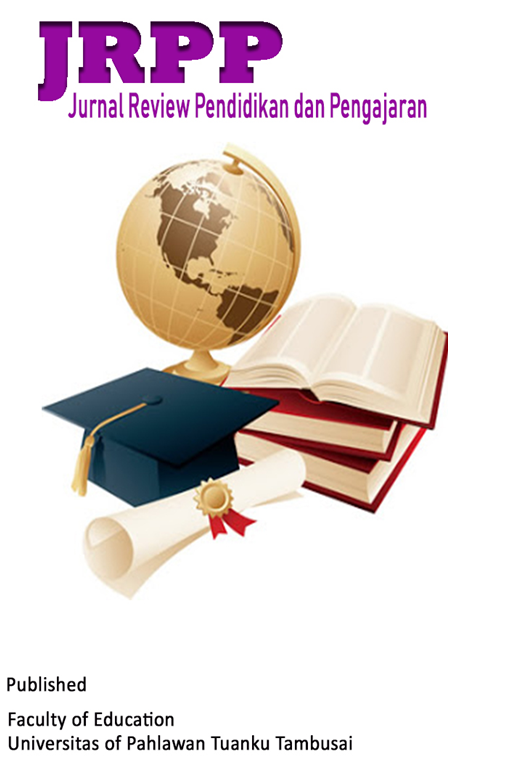PELATIHAN PENERAPAN BLENDED LEARNING MENGGUNAKAN MODEL FLIPPED CLASSROOM DI MAN 1 KAMPAR PADA ERA NEW NORMAL
DOI:
https://doi.org/10.31004/cdj.v2i1.1488Keywords:
Keywords, Blended Learning, Flipped Classroom, Covid19Abstract
Learning in the new normal era during the Corona Virus Disease 2019 (COVID-19) pandemic requires teachers to be more innovative and creative in preparing for learning. This activity is carried out in helping teachers to provide quality new normal education so that the learning objectives are achieved properly. The approach presented is participatory action research (PAR) with activity partners at Madrasah Aliyah Negeri (MAN) 1 Kampar. The activity is carried out in three stages, namely problem identification, activity implementation and activity evaluation. The activity was attended by 20 teachers, and the material provided included blended learning using the flipped classroom method. The result of this activity is the teacher's ability to understand the implementation of the flipped classroom model that is depicted during the simulation after the training is carried out. The indicators of the success of this community service implementation are activities carried out according to plan, as well as positive responses from participants.References
Abeysekera, L., & Dawson, P. (2015). Motivation and cognitive load in the flipped
classroom: definition, rationale and a call for research. Higher Education
Research and Development, 34(1), 1–14.
https://doi.org/10.1080/07294360.2014.934336
Bergmann, J., & Sams, A. (2014). Flipped learning: Gateway to student engagement.
Learning & Leading with Technology, May 2014, 18-23.
Berrett, D. (2012). How ‘flipping’ the classroom can improve the traditional lecture. The
Chronicle of Higher Education, February 19, 2012. Overmyer, J. (2012). Flipped classrooms 101. Principal, September/October 2012, 46-
Bramasta, Dandy Bayu. (2020). "Mengenal Apa Itu New Normal di Tengah Pandemi Corona...". Diakses tanggal 20 Mei 2020 dari https://www.kompas.com/tren/read/2020/05/20/063100865/mengenal-apa-itu-new- normal-di- tengah-pandemi-corona-
Brian, A., and K.N. Volchenkova. (2016). Blended Learning: Definition, Models, Implication for Higher Education. Bulletin of the South Ural State University. Ser. Education. Educational Sciences. vol. 8, no. 2, pp. 24–30. Diaksesdari https://www.researchgate.net/publication/303815166_BLENDED_LEARNING_DEFINITIO N_M ODELS_IMPLICATIONS_FOR_HIGHER_EDUCATION
Bruner, J. (1960). The process of education. Cambridge, MA: Harvard University Press.
Bull, G., Ferster, B., & Kjellstrom, W. (2012). Inventing the flipped classroom.
Learning & Leading with Technology, 40.1, August 2012, 10-12.
Chaeruman, Uwes A. (2020). Tips Implementasi Flipped Learning. Materi disajikan dalam Webinar APSTPI 2020.
Chaeruman, Uwes A. dan Santi Maudiarti. (2018). Quadrant of Blended Learning: a Proposed Conceptual Model for Designing Effective Blended Learning. Jurnal Pembelajaran Inovatif1(1) (2018): 1-5.Diakses pada tanggal 24 Mei 2020 dari http://journal.unj.ac.id/unj/index.php/jpi/article/view/5924/4373
Dziubal, Charles., et.al. (2018). Blended learning: the new normal and emerging technologies. International Journal of Educational Technology in Higher Education volume 15, Article number: 3. Diakses pada tanggal 24 Mei 2020 dari https://educationaltechnologyjournal.springeropen.com/articles/10.1186/s41239- 017-0087-5
Graham, Charles R. (2006). “ Blended Learning Systems: Definition, Current Trends, and Future Directions†dalam Bonk, J. Curtis dan Charles R. Graham (ed.). The Handbook of Blended Learning: Global Perspectives, Local Designs (pp. 3-21). Diakses dari https://books.google.co.id/books?id=2u2TxK06PwUC&printsec=frontcover&source =gb s_ge_summary_r&cad=0#v=onepage&q&f=false
Lembaga Penjaminan Mutu Pendidikan Lampung. (2020). Laporan Evaluasi Pelaksanaan Belajar dari Rumah. Tidak diterbitkan.
Soler, Rebeca., Juan Ramon Soler, Isabel Araya. (2017). Subjects in The Blended Learning Model Design. Theoretical Methodological Elements. Journal Social and Behavioral Sciences, 237, 2017, (771–777). Diakses dari https://www.sciencedirect.com/science/article/pii/S1877042817301209
Thorne, K. (2003). Blended Learning: How to Integrate Online and Traditional Learning. London, UK: Kogan Page Limited.
Yuniarto, Eko. (2015). Penerapan Evaluasi pada Blended Learning Berbasis Moodle dalam Pembelajaran Kimia di Perguruan Tinggi. Jurnal Likhitaprajna, 17(2), 65-85. Diakses dari http://likhitapradnya.wisnuwardhana.ac.id/index.php/likhitapradnya/article/view/17
















